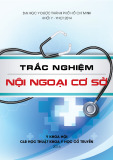
JOURNAL OF 108 - CLINICAL MEDICINE AND PHARMACY Vol. 19 - Dec./2024 DOI: https://doi.org/10.52389/ydls.v19ita.2513
70
A case of herpes zoster duplex unilateralis in an
immunocompetent patient
Le Minh Chau, Bui Phuong Linh
and Nguyen Thi Quynh Trang*
108 Military Central Hospital
Summary
Herpes zoster duplex is a rare condition, which simultaneously affects two different noncontiguous
dermatomes. Herpes zoster duplex unilateralis affects two noncontiguous dermatomes and presents on
one side of the body, while herpes zoster duplex bilateralis - on both sides of the body. Usually, the
presentation of herpes zoster duplex is usually associated with immunodeficiency. In this article, we
report a case of herpes zoster duplex unilateralis occured in an immunocompetent man. A 70-year-old
man presented with painful erythematous grouped vesicles on his left trunk and left buttock.
Keywords: Herpes zoster duplex, clinical report, immunocompetent.
I. BACKGROUND
Herpes zoster (HZ) duplex is a very rare
phenomenon, with an incidence of less than 0.1% of
all HZ cases11. Risk factor for developing HZ duplex is
immunodeficient condition (e.g. HIV individuals or
those using immunosuppressive medications)6, 10.
Primary VZV infection induces VZV-specific
antibodies and VZV-specific T cell-mediated
immunity13. When the immune system weakens, due
to aging, HIV/AIDS, radiotherapy or malignancy, the
virus reactivation starts and causes herpes zoster8.
However, it can also occur in immunocompetent
hosts. Herein, we present a case of herpes zoster
duplex unilateralis in an immunocompetent patient.
II. CASE PRESENTATION
A 70-year-old man presented with a 5-day
history of vesicular eruption on erythematous base
over left side of the trunk and a similar eruption on
left buttock. Earlier that day, he felt dull, persistent
pain in the affected area, with no
lymphadenopathies, fever or headache. Three days
Received: 18 September 2024, Accepted: 27 October 2024
*Corresponding author: quynhtrangdl108@gmail.com -
108 Military Central Hospital
later, disseminated satellite lesions appeared on the
face, lesions on the left trunk and buttock evolved
into pustules [Figure 1-2]. The patient was treated
with antihistamines for 3 days however there was no
response, which caused him to seek medical
attention. He has a history of hypertension, diabetes
type II and dyslipidemia. He had no risk factors for
HIV, no prior diagnosis of herpes virus infection, and
had not received the VZV-vaccine.
On physical examination, groups of vesicles and
pustules, some had crusted, on erythematous base
were noted on the left thoracic area T4-T5 and those
on left buttock spreading to the inner left thigh
[Figure 1]. The patient described his pain as burning
intermittent pain, which was estimated 5 on a 1-10
Likert scale. VZV polymerase chain reaction from
blood was positive. Examination for
immunodeficiency, such as HIV antibody, was
negative. Patient’s complete blood cell count and
serum creatinine level were normal, CRP, AST and
ALT were higher than normal: 10.7mg/l, 41.1U/I and
57.5 U/I, respectively.
A course of oral acyclovir 800mg five times a
day for seven days, cefixime 200mg twice a day for
seven days and other symptomatic management,
including pregabalin 300mg twice a day, as well as

JOURNAL OF 108 - CLINICAL MEDICINE AND PHARMACY Vol. 19 - Dec./2024 DOI: https://doi.org/10.52389/ydls.v19ita.2513
71
wet dressing with diluted solution of potassium
permanganate twice a day to vesicles and pustules,
then topical Fucidin to crusts were administered.
New solitary vesicles and erosions developed on the
penis on the third day of treatment [Figure 2]. After
seven days of treatment, all of the lesions became
dry and formed discrete crusts, and pain intensity
was also reduced to 2 points on a 0-10 Likert scale.
Additional follow-up was recommended after
discharge.
Figure 1. Grouped vesicular and pustular eruption in the left thoracic area T4-T5
and those on the left buttock spreading to the inner left thigh.
Figure 2. Satellite lesions on the face and penis
III. DISCUSSION
Herpes zoster is caused by reactivation of VZV,
usually restricted to one dermatome and presented
with unilateral pain and vesicular eruption. The
reason why reactivation of VZV only occurs in a
single dermatome is probably due to effects of the
highest viral genome load on a specific dermatome
and prevention of VZV spread by the immune
system9. As a result, simultaneously reactivation of
multiple dermatomes is involved in cases of
systemic immunosuppression. The pathogenesis of
satellite lesions remains unclear4. Hence,
multidermatomal HZ occurs in the absence of an

JOURNAL OF 108 - CLINICAL MEDICINE AND PHARMACY Vol. 19 - Dec./2024 DOI: https://doi.org/10.52389/ydls.v19ita.2513
72
immunodeficient state is considered a rare
phenomenon.
In this case report, the diagnosis was supported
by clinical pictures and positive results from VZV
polymerase chain reaction. Although this patient did
not have a severe immunodeficiency condition such
as HIV or use of immunosuppressive drugs, there are
still risk factors for herpes zoster duplex of this case
to occur, which are age and comorbidities. Older
age is a major risk factor for both herpes zoster and
herpes zoster duplex. Wei Li et al (2017) found that
absolute numbers of CD3+ and CD8+ were lower by
age, increasing risk of having HZ in the elderly12. Our
patient is 70-years-old and, as known, the incidence
of HZ increases with increasing age; most patients
suffering from HZ are > 50 years old2.
Besides, the male patient had a history of
hypertension, diabetes type II and dyslipidemia. We
speculate that it could lead to defective cellular
immune response, allowing the development of
zoster duplex unilateralis13. Feng Zhang and Jin
Zhou (2015) analyzed 36 cases with herpes zoster
duplex, in which 16 cases (44.4%) involve individuals
≥ 50 years of age, and 17 cases (47.2%) - individuals
with immunocompromised states5. Also according
to this study, 24 cases (66.7%) were from Asia5. This
patient was also an Asian. Almuneef et al (2004)
reported that Asian individuals are more susceptible
to VZV, while East Asians are more susceptible to
other viruses including Epstein-Barr virus and
hepatitis B7. VZV-IgG was observed lower in sera in
healthy Asian individuals than of those residing in
other regions1. The highest number of HZ duplex
patients was observed in Asia, suggesting a genetic
susceptibility for developing HZ duplex. It seems
that HZ duplex is not a risk factor for poor prognosis
and postherpetic neuralgia3. The patient got a good
response to antiviral agent, pain management, and
care of the skin lesions. After 7 days, all of the lesions
became dry and formed crusts. He had almost no
pain left. Once again, treatment effectiveness
confirmed our diagnosis of herpes zoster.
IV. CONCLUSION
In conclusion, herpes zoster duplex uniteralis
and bilateralis is a rare phenomenon. This condition
is more common in immunocompromised
individuals. Certainly, if a patient is presenting with
herpes zoster duplex, additional examinations are
needed to be done to exclude immunodeficiency.
However, herpes zoster duplex can be presented in
immunocompetent patients. The sooner the
treatment is administered the better the prognosis.
The treatment was the same as for the more
common form of herpes zoster, which included an
antiviral agent, pain management, and care of the
skin lesions. The patient’s skin lesions and pain
subsided without any complications.
REFERENCES
1. Lee BW (1998) Review of varicella zoster
seroepidemiology in India and Southeast Asia. Trop
Med Int Health 3: 886-890.
2. Yawn BP, Saddier P, Wollan PC, St Sauver JL,
Kurland MJ, Sy LS (2007) A Population-Based Study
of the Incidence and Complication Rates of Herpes
Zoster Before Zoster Vaccine Introduction. Mayo
Clinic Proceedings 82(11): 1341-1349.
doi:10.4065/82.11.1341.
3. Castronovo C, Nikkels AF (2012) Chronic herpes
zoster duplex bilateralis. Acta Derm Venereol
92:148-151.
4. El Hayderi L, Bontems S, Nikkels-Tassoudji N,
Arrese JE, Seidel L, Meex C, Nikkels AF (2015)
Satellite lesions accompanying herpes zoster: A new
prognostic sign for high-risk zoster. Br J Dermatol
172(6): 1530-1534.
5. Zhang F, Zhou J (2015) Zoster duplex: A clinical
report and etiologic analysis. Int J Clin Exp Med 8(7):
11020-11025.
6. Forbes HJ, Bhaskaran K, Thomas SL, Smeeth L,
Clayton T, Langan SM (2014) Quantification of risk
factors for herpes zoster: population based case-
control study. BMJ 348:g2911.
7. Wee J, Nei WL, Yeoh KW, Yeo RM, Loong SL, Qian
CN (2012) Why are East Asians more susceptible to
several infection-associated cancers (carcinomas of

JOURNAL OF 108 - CLINICAL MEDICINE AND PHARMACY Vol. 19 - Dec./2024 DOI: https://doi.org/10.52389/ydls.v19ita.2513
73
the nasopharynx, stomach, liver, adenocarcinoma of
the lung, nasal NK/T-cell lymphomas)? Med
Hypotheses 79: 833-842.
8. Zhang JX, Joesoef RM, Bialek S, Wang C, Harpaz R
(2013) Association of physical trauma with risk of
herpes zoster among Medicare beneficiaries in the
United States. J Infect Dis 207(6): 1007-1011.
9. Levin MJ, Schmader KE, Oxman MN
(2019) Varicella and Herpes Zoster. In: Kang S,
Amagai M, Bruckner AL, Enk AH, Margolis DJ,
McMichael AJ, Orringer JS. eds. Fitzpatrick's
Dermatology, 9e. McGraw-Hill Education.
Accessed January 06,
2025. https://accessmedicine.mhmedical.com/con
tent.aspx?bookid=2570§ionid=210439369.
10. Buchbinder SP, Katz MH, Hessol NA et al (1992)
Herpes zoster and human immunodeficiency virus
infection. J Infect Dis 166(5): 1153-1156.
11. Thomas SL, Hall AJ (2004) What does epidemiology
tell us about risk factors for herpes zoster? Lancet
Infect Dis 4: 26-33.
12. Wei L, Zhao J, Wu W, Zhang Y, Fu X, Chen L, Wang
X (2017) Decreased absolute numbers of CD3+ T
cells and CD8+ T cells during aging in herpes zoster
patients. Sci Rep 7(1):15039.
13. Weinberg A, Levin MJ (2010) VZV T cell-mediated
immunity. Curr Top Microbiol Immunol 342: 341-357.











![Tài liệu Triệu chứng học nội khoa [mới nhất]](https://cdn.tailieu.vn/images/document/thumbnail/2025/20251204/oanhlahet@gmail.com/135x160/5231764900514.jpg)


![Bài giảng Vi sinh vật: Đại cương về miễn dịch và ứng dụng [chuẩn nhất]](https://cdn.tailieu.vn/images/document/thumbnail/2025/20251124/royalnguyen223@gmail.com/135x160/49791764038504.jpg)











